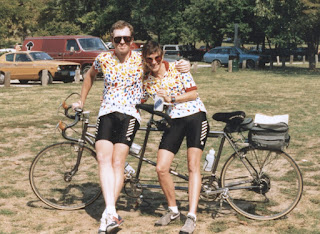 |
| Linda and I at the finish of the Wabash River Ride century, 1986. |
The Good: Muscle aches from exercise and fatigue is the “good” pain. Post-exercise aches are a natural part of your muscles being used and getting stronger. It is also good sign that you are challenging yourself. Some of these aches will be immediate, but don’t be surprised after a long or strenuous ride, you don’t feel the ache in your muscles until the next day.
Relief can come from rest, light stretching, or even an easy recovery ride. A recovery activity will warm tired muscles and increase blood flow, whch in turn removes fatigue agents and speeds your recovery. The good news is that with consistent exercise, your body will improve in condition, and your easier rides are less like to cause post-ride muscle aches.
The Bad: The pain from contact points, saddle, hands and feet, while not debilitating, can take the fun out or your riding. While minor issues are another part of the training cycle, recurring or persistent contact pain all relate to bike fit, riding technique and gear.
If your bike does not fit you properly, it will be hard to be comfortable on longer rides. The wrong seat height or seat angle, improper foot position or the wrong stem length, can all contribute to aches and pains. The modest investment in a basic profession bike fit can make a very big difference in your riding comfort.
Riding technique comes next after fit. Would you sit in an office chair for 2-3 hours with changing position? The same goes for cycling. Regular lifting off the saddle (every 10 minutes or so) is a good way to alleviate saddle pain, and is important for any style of bike or saddle. Moving your hands around the handle bars as your ride change both your seating and contact on your hands.
And of course, the right gear makes a difference. A few good pairs of cycling shorts will help you stay comfortable in the saddle. A cycling specific shoe, even without a retention system, will help prevent foot and ankle issues. Padded gloves and additional handle bar padding makes a difference too. (More gear details were covered in Week 5.)
The Ugly: Pain from Repetitive Motion is your greatest concern. The knee joint is the most common cycling complaint, but some riders may experience hip or ankle issues. These can occur with improper fit, poor technique, or from riding to far or too hard too early in your training. If you feel a sharp pain in the joints with motion, your body is telling you something is wrong, and should be taken care of immediately.
You should not ignore or ride through severe joint pain, since the only real recovery is time (and possibly specialist prescribed therapy). Persistent joint pain after extended rest should may also require a visit to the doctor, especially if it interferes with your normal movements and activities. The good news about all this is that today there are many more resources for active athletes of all ages when it comes to finding knowledgable, medical resources.
One of the beautiful things about bicycling is its potential to be life long, injury free activity. It will be perfectly normal to have some aches and pains during your training and events. What is important now, and has you gain experience each riding season, is learning to "read" your body has it adapts to longer rides and your improving fitness. And has you gain experience, you will learn to get the most out of your body, so that you are always riding in comfort and pain free.
Download the #10weeksto100 Training Framework
Week 6 of the #10weeksto100.
Continue to Week 7: How To Find the Time
The series is intended as mentoring, rather than athlete specific coaching. The being the case, these are broad, general guidelines of a riding style and philosophy. You can find the series intro here - Preparing for Your First Long Ride or Century
The series is intended as mentoring, rather than athlete specific coaching. The being the case, these are broad, general guidelines of a riding style and philosophy. You can find the series intro here - Preparing for Your First Long Ride or Century














